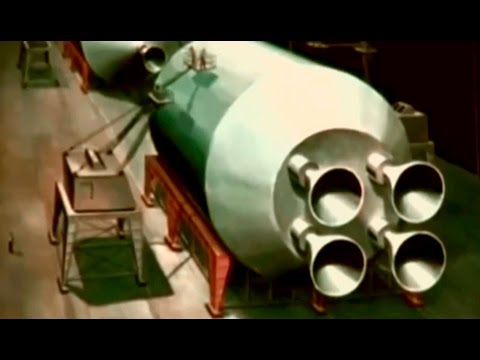Manned Interplanetary Missions 1962 NASA-General Dynamics, Krafft Ehricke
more at
“A Study of Early Manned Interplanetary Missions” is a report by General Dynamics Astronautics Director of Advanced Studies Krafft Ehricke under NASA contract # NAS8-5026. This 1962 report considers the possibilities for manned interplanetary missions to Mars and Venus which would take place in the 1970’s. Use of a NERVA (Nuclear Engine for Rocket Vehicle Applications) engine, or a more advanced metal carbide nuclear engine, is assumed for all but one of the suggested mission profiles.
Public domain film from NASA, slightly cropped to remove uneven edges, with the aspect ratio corrected, and mild video noise reduction applied.
The soundtrack was also processed with volume normalization, noise reduction, clipping reduction, and/or equalization (the resulting sound, though not perfect, is far less noisy than the original).
Krafft Arnold Ehricke (March 24, 1917 – December 11, 1984) was a German rocket-propulsion engineer and advocate for space colonization…
Biography
Born in Berlin, Ehricke believed in the feasibility of space travel from a very young age, influenced by his viewing of the Fritz Lang film Woman in the Moon. At the age of 12, he formed his own rocket society. He attended Berlin Technical University and studied celestial mechanics and nuclear physics under such luminaries as Hans Geiger and Werner Heisenberg, attaining his degree in Aeronautical Engineering.
He worked at Peenemünde as a propulsion engineer from 1942 to 1945 with Walter Thiel, then went to the United States with other German rocket scientists and technicians under “Operation Paperclip” in 1947. He worked for a short time with the Von Braun Rocket Team at Huntsville.
In 1948, while working for the U.S. Army, Ehricke wrote a story about a manned mission to Mars called “Expedition Ares”. It anticipated the many challenges that still face explorers who will make the journey in the future. In the same year he wrote a book with Wernher von Braun, The Mars Project, which detailed how man could travel to Mars using a ferry system.
Upon leaving government service Ehricke worked at Bell Aircraft, and then for Convair in 1952. While at Convair, he designed the D-1 Centaur, the world’s first upper-stage-booster that used liquid hydrogen and oxygen. He also created an early space station design, based on launch by Convair’s Atlas rocket. The NEXUS reusable rocket was a 1960s concept design by a group at General Dynamics led by Krafft Ehricke. Also, during his stay at General Dynamics, he participated on Project Orion (nuclear propulsion).
Krafft Ehricke undertook a major, multi-decade study of the industrial development of the Moon, which he described as Earth’s “seventh continent.” His lunar industrialization concept was based on the most advanced technologies, such as nuclear-powered freight transporters, and using fusion energy to power his city, Selenopolis, on the Moon.
Ehricke received a space burial on April 21, 1997, when a rocket sent a small amount of his cremated remains into Earth orbit…
Interplanetary spaceflight or interplanetary travel is travel between planets, usually within a single planetary system. In practice, spaceflights of this type are confined to travel between the planets of the Solar System…
NERVA is an acronym for Nuclear Engine for Rocket Vehicle Application, a U.S. nuclear thermal rocket engine development program that ran for roughly two decades. NERVA was a joint effort of the U.S. Atomic Energy Commission and NASA, managed by the Space Nuclear Propulsion Office (SNPO) until both the program and the office ended at the end of 1972.
NERVA demonstrated that nuclear thermal rocket engines were a feasible and reliable tool for space exploration, and at the end of 1968 SNPO certified that the latest NERVA engine, the NRX/XE, met the requirements for a manned Mars mission. Although NERVA engines were built and tested as much as possible with flight-certified components and the engine was deemed ready for integration into a spacecraft, much of the U.S. space program was cancelled by the Nixon Administration before a manned visit to Mars could take place.
NERVA was considered by the AEC, SNPO and NASA to be a highly successful program; it met or exceeded its program goals. Its principal objective was to “establish a technology base for nuclear rocket engine systems to be utilized in the design and development of propulsion systems for space mission application”. Virtually all space mission plans that use nuclear thermal rockets use derivative designs from the NERVA NRX or Pewee…

